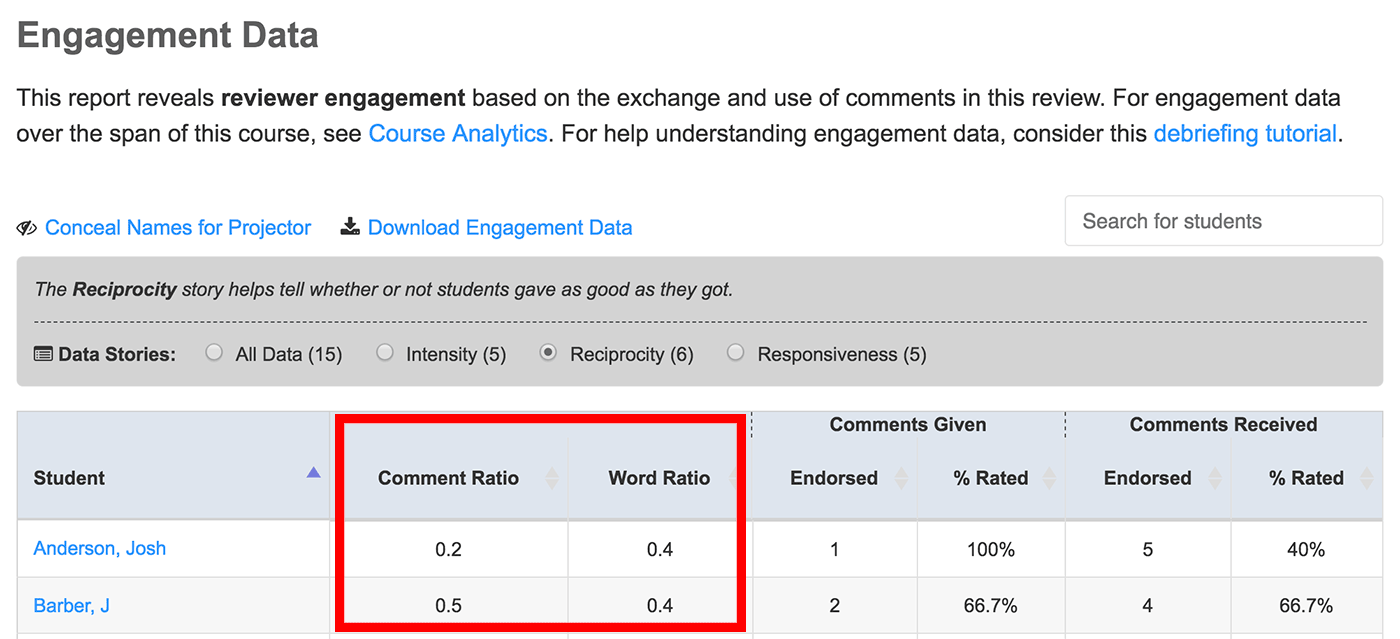When students give helpful feedback to peers and get it back on their own writing, they are happy. When students work hard at being helpful reviewers and don’t get helpful feedback in return, they are grumpy. The feedback culture of a class—happiness or grumpiness—has a lot to do with the perceived balance in the feedback that students gave and got.
How do you pay attention to give/get patterns?
In Eli Review, you can use the reciprocity data story to pay attention to patterns in students’ giving and getting feedback. In any review task, click on the Engagement tab, then choose the reciprocity data story.

The quickest way to find an uptake problem is to click on the header for “word count ratio” and sort the column from least to most. Here’s a scale:
- Below 0.5=red flag! Student is getting double or more the feedback they gave.
- Above 0.8 = good reciprocity
- 1 = perfect reciprocity.
- Below 1.2 = good reciprocity
- Above 1.2 =ok reciprocity
- Above 2=red flag! Student is giving double the feedback they got.
What do you do about reciprocity problems?
Reciprocity problems usually indicate other problems. Read the feedback by students who gave too much and those gave too little to gauge what’s going on.
To change the reciprocity patterns, you are likely to take these next steps.
With Reviewers Giving Too Little
Re-teach describe-evaluate-suggest.
Often, reviewers writing short comments are offering praise because they don’t know what else to say. They feel insecure offering feedback to writers they perceive to be stronger than them. Showing these students a couple of comments from strong peers and talking through the describe-evaluate-suggest moves in those examples can help.
Expand the criteria.
Sometimes reviewers who aren’t contributing as much as peers are stuck commenting on exactly the same criteria in every review. For example, they’ll always write about the thesis and commas but never about evidence and audience. Telling these students that they should challenge themselves to offer one comment about each of the criteria in the review task can help them contribute more.
Confront disengagement.
Students do the minimum for many good reasons. Ask why, and go from there.
With Reviewers Giving Too Much
Check for long quotes.
Reviewers sometimes copy passages from the draft and paste them in their comments. This practice usually results in excellent feedback but not always. If students have figured out that a high word count is valued, make sure they also know that you see them inflating word count too.
Ask the reviewer to imagine a writer’s response.
Reviewers who give a lot of feedback are sometimes following the golden rule to give what you want to receive, which we advocate in “Feedback and Improvement” in order to encourage reciprocity. But, writers have different appetites for feedback. Asking a reviewer to read the feedback they gave aloud and then asking them to imagine how a hesitant writer or a harried writer might receive it can help them adjust their feedback with a more nuanced sense of audience.
Encourage revision of comments.
Some reviewers arrive at their best feedback by writing a lot of feedback. These reviewers need to revise their feedback to focus on their best suggestions before sending to writers. Deleting good insights for the best ones is particularly hard for reviewers. Again, paying attention to how much feedback other writers can handle helps.
Find your tolerance range for reciprocity problems.
We examined reciprocity in more than 60 classes last year. Almost every class had reciprocity problems. Only graduate/professional classes where students are well-matched in terms of ability and motivation have narrow reciprocity differences. So, decide which reciprocity ratios are a red flag for you, and notice the proportion of students earning those red flags. Peer learning is robust enough that a few red flags for over/under contribution will be fine, but a lot of red flags will color the experience for everyone.
Mind the gap between the feedback reviewers are giving and getting; everyone is happier with reciprocity.

